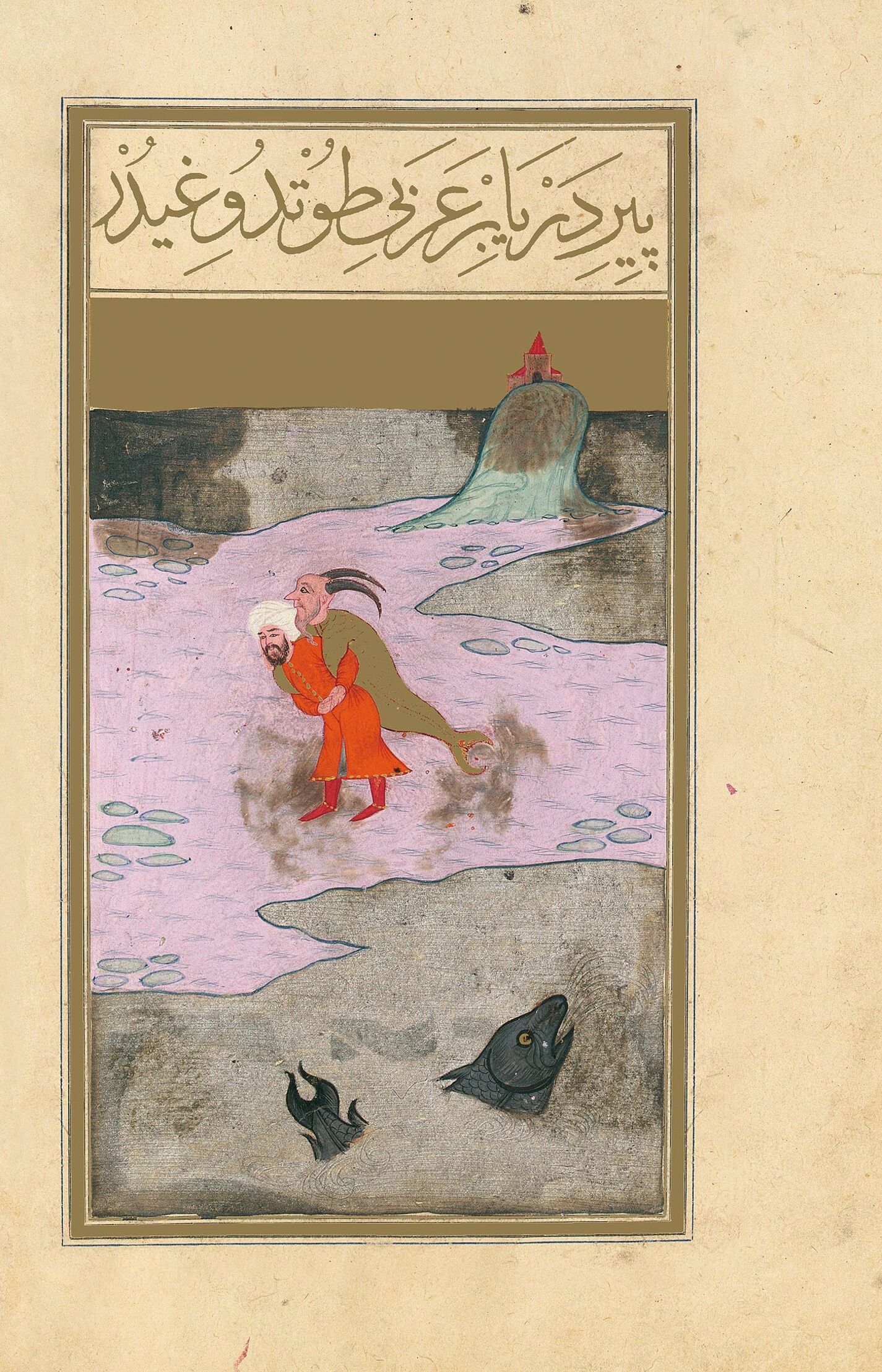The story illustrated here is most likely taken from the most famous Arab tales, the compilation known as The Thousand and One Nights, which is itself based on a large number of different oral and written sources. One of the tales told by Sinbad the Sailor is about how he came across an old man on a desert island where he was cast up after a shipwreck. He helped him by carrying him on his shoulder, but the Old Man of the Sea wrapped his legs tightly around Sinbad’s body and would not let go, ordering him around and beating him every time the sailor protested. Eventually Sinbad came across a grape vine. He picked some grapes to make some juice and exposed it to the sun. When it fermented he gave it to the nasty old man who became drunk and released his grip. The sailor quickly freed himself of his burden, threw him to the ground and killed him with a stone.
Once again, in order to understand the story one needs to compare the present illustration with the original painting in the Kitab al-bulhan (f. 43r), where the scene is set against the background of a large vine tree with a wine bucket on the ground next to the two intertwined figures. In the Ottoman painting, the artist retained only the two men in the same position, the Old Man of the Sea represented as a fish with a human head and his arms – rather than his legs as described in the story – wrapped around Sinbad’s body. The creature has two pointed horns which do not appear in the Kitab al-bulhan. But in the present case there is no trace of the vineyard nor the wine that will bring an end to the story. Rather, deliberately or not, the scene is set in a broad coastline landscape with a large fish in the foreground and a house on a hill in the background, immediately after Sinbad rescues the creature from the sea and is trapped in his grip.
Stefano Carboni
The Metropolitan Museum of Art
Curatorial Assistant in Islamic Art
(Fragment of the Book of Felicity commentary volume)

The story illustrated here is most likely taken from the most famous Arab tales, the compilation known as The Thousand and One Nights, which is itself based on a large number of different oral and written sources. One of the tales told by Sinbad the Sailor is about how he came across an old man on a desert island where he was cast up after a shipwreck. He helped him by carrying him on his shoulder, but the Old Man of the Sea wrapped his legs tightly around Sinbad’s body and would not let go, ordering him around and beating him every time the sailor protested. Eventually Sinbad came across a grape vine. He picked some grapes to make some juice and exposed it to the sun. When it fermented he gave it to the nasty old man who became drunk and released his grip. The sailor quickly freed himself of his burden, threw him to the ground and killed him with a stone.
Once again, in order to understand the story one needs to compare the present illustration with the original painting in the Kitab al-bulhan (f. 43r), where the scene is set against the background of a large vine tree with a wine bucket on the ground next to the two intertwined figures. In the Ottoman painting, the artist retained only the two men in the same position, the Old Man of the Sea represented as a fish with a human head and his arms – rather than his legs as described in the story – wrapped around Sinbad’s body. The creature has two pointed horns which do not appear in the Kitab al-bulhan. But in the present case there is no trace of the vineyard nor the wine that will bring an end to the story. Rather, deliberately or not, the scene is set in a broad coastline landscape with a large fish in the foreground and a house on a hill in the background, immediately after Sinbad rescues the creature from the sea and is trapped in his grip.
Stefano Carboni
The Metropolitan Museum of Art
Curatorial Assistant in Islamic Art
(Fragment of the Book of Felicity commentary volume)